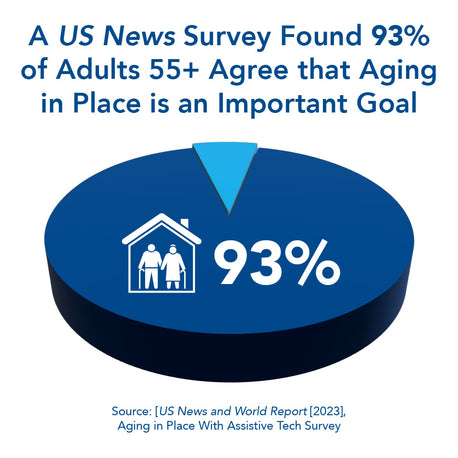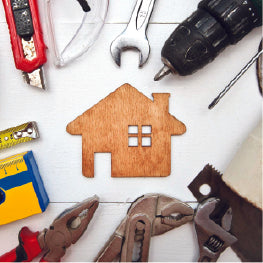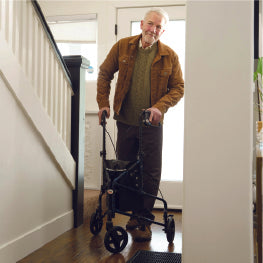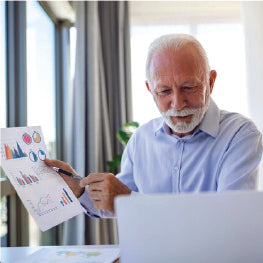The Ultimate Aging in Place Checklist
A Step-by-Step Checklist for Aging in Place
Related Articles
- The Ultimate Guide to Aging in Place
- Aging in Place Statistics
- The Ultimate Aging in Place Checklist
- The Pros and Cons of Aging in Place
- The Most Common Aging in Place Mistakes and How to Avoid Them
- Tips to Make Aging Gracefully More Manageable
93% of adults 55+ believe aging in place is an important goal.
However, while an essential goal for many, it takes much work. The aging process can bring many struggles, including:
- Increased fall risk
- Decreased ability to do home tasks
- Decreased driving ability from vision impairment
- And chronic health conditions.
Older adults must compensate for challenges threatening their independence to realize this dream.
This checklist for seniors serves as a guide to walk you through the necessary steps to age from the comfort of home. Our checklist goes beyond aging in place remodeling, but embodies all the steps needed to maintain independent living. This includes technology and assistive services, healthcare, mobility, fall prevention, and financial planning.
Following this guide will ensure you're well-prepared to age from the comfort of your home.


Home Modifications and Improvements
Did you know only 10% of American homes are considered aging-ready?
This threatens aging in place as seniors may lack the necessary support from their living environment. This section serves as an aging in place remodeling checklist, covering home changes to make it safe and comfortable.
General Tips
- Remove any fall hazards, such as loose rugs and clutter.
- Create an open environment by removing tight spaces (especially if you use a mobility aid).
- Add adequate lighting to improve visibility, especially at night.
- Add night lights throughout the home.
- Install rocker light switches if you struggle with traditional switches.
- Remove any chairs with rolling wheels, as they can increase the chances of falls.
Fire Safety
- Ensure there are adequate fire detectors in the home and they all work.
- Check all electrical cords for damage and replace them if needed.
- Ensure all appliances are in working condition and replace any if required.
- Ensure all outlets are not overcrowded, and use extension cords where needed.
- Keep candles at a safe distance from flammable items.
- Remove them if required. Have a fire evacuation plan.
- Check that furnaces and air conditioners are properly maintained.
- Contact a professional to check if needed.
- Install a carbon monoxide detector.
Home Security
- Install camera systems to keep an eye on things while away.
- Install a peephole to see who's at the door.
- Install a security system.
- Install a mail slot to prevent mail theft.
- Check that all windows and doors can close and are locked.
- Take note of who has keys to the home, and replace your locks if needed.
- Make sure all keys work and with which entry point.
- Place them on a key holder near the front door.
Bathroom
- Install a grab bar in or around the shower/tub to provide standing support.
- Install a shower chair or transfer bench if you struggle to stand while bathing.
- Add a handheld shower spray to reduce strain.
- Move bathroom counter toiletries to one place to minimize movement.
- Ensure any medications kept in the bathroom are labeled and easily accessible.
- Consider using a pill organizer. Keep toilet paper stocked near the toilet within arm's reach.
- Install a raised toilet seat or safety rail if you struggle to sit or stand.
- Limit water temperature to prevent accidental hot water burns.
- Ensure towels are easy to access near the shower/tub. Consider installing a towel holder nearby.
Kitchen
- Install a faucet with a single lever that's easier to turn on/off.
- Check to see if you can reach all the items in the cupboards. If not, consider lowering the cabinets or keeping items in lower areas.
- Consider installing drawer organizers, wall racks, or pull-out shelving. Install an auto-off oven and stove to prevent fires.
- Add a kitchen stool if you struggle to stand for long periods.
- Keep heavier items in easier-to-reach places.
- List any food allergies and keep them on your fridge.
Stairs
- Install handrails going up and down the stairs.
- Install a stairlift if you struggle significantly going up/down stairs.
- Locate sturdy furniture near the top and bottom of stairs for support.
- Add non-slip flooring or textured strips on stair edges.
- Install light switches near the top and bottom of stairs to prevent going up/down in the dark.
Bedroom
- If you struggle to get in/out of bed, install a bed rail to prevent falls.
- If you have challenges accessing clothes, consider removing your dresser or hangers for something more manageable.
- Consider adding a commode near the bed to avoid late-night accidents if you have significant mobility issues.
- If stairs are too hard to navigate, move a bedroom downstairs by converting an office into a bedroom.
Living Room
- Ensure the TV is secure and not at risk of falling. Consider hanging it on the wall for more space and safety.
- Add extra storage, such as side tables, coffee tables, and other furniture, to clear any clutter.
- Arrange furniture to open up space for fall prevention.
- Keep items such as lamps away from vulnerable corners to prevent them from falling.
Hallways
- If you use a mobility aid, ensure you can get through easily without bumping into any objects. If you cannot, consider removing items or widening the halls for added space.
- Line the floors with nightlights for nighttime visibility.
- Install light switches near each doorway for easy access.
- Check any hanging pictures to ensure they won't fall easily if bumped.
Garage
- Ensure the garage door can easily open from the outside.
- Clear loose wires, tools, or equipment that may be a trip hazard.
- Ensure any stairs are adequately lit to prevent falls.
- Ensure any flammable liquids are labeled and stored correctly in tight containers.
Outside and Around the House
- Swap out lower floorboards for raised garden boxes.
- Utilize a stable source of sitting support.
- Install lights that turn on when it gets dark.
- Ensure clear pathways around the house are void of any trip hazards.
- Keep salt for ice stocked for when it snows.
- Cut or remove any overgrown plants.
- If needed, install a wheelchair ramp.
- If yard maintenance is an issue, remove any plants that require a lot of maintenance.
- If any bodies of water exist around the house, check for any surrounding trip hazards.

Technology and Assistive Services
Technology is a common theme amongst seniors aging from home. 61% of adults 65+ own a smartphone. Additionally, 49% of older adults report having at least one smart home device.
Regarding aging from home, utilizing assistive services can also significantly help. These services are more affordable than nursing homes.
Below, we list technology and assistive services worth considering.
Technology To Consider
- Medical alert systems: Allow you to call for help in the case of an emergency such as a fall or illness.
- Medication management devices: Remind you when to take your medications.
- Assistive listening devices: Make it easier to hear conversations and other audio.
- Smart home devices: These devices can be used to turn on lights, adjust the thermostat, lock doors, and more.
- Video doorbells: Allow you to see who is at your door before you open it.
- Telehealth: Allows you to see a healthcare provider from home.
- Fitness trackers: These devices can track steps, heart rate, and other activities and notify you when to move.
- Automated blood pressure monitors: These allow you to take your blood pressure from home.
Assistive Services to Consider
- Friends and family members: They can help with daily living activities and transportation without additional costs.
- Professional home care services: Provide various services such as personal care, homemaking, skilled nursing care, and technology assistance.
- Adult daycare: This can be a way to get outside your home for social connection.
- Transportation services: These can be helpful if you are unable to drive. These include public transportation, ride-sharing apps (Lyft/Uber), and senior-specific programs.
- Certified aging in place specialists: Specialists undergo training to modify homes and make them more friendly for aging in place.
- Delivery services: Companies such as Uber and Doordash can deliver groceries, removing the need to go into stores.

Healthcare, Mobility, and Fall Prevention
Good mental, physical, and emotional health are cornerstones of independence. Without them, aging in place is not possible. Below, we highlight key steps to take regarding healthcare, mental and emotional well-being, mobility, and fall prevention.
Healthcare
- Plan out doctor visits to stay on top of your health (don't wait until you have a health problem to see your doctor).
- Get regular vision and hearing exams (vision/hearing loss is often more noticeable by outside sources).
- Compile a list of healthcare specialists you may need based on existing conditions. Keep their contact information in a safe/secure location.
- Have a well-stocked first aid kit with essential items. This can include bandages, antiseptic wipes, pain relievers, and allergy medication. Be sure to include items that are specific to any conditions.
- Create an easily accessible file with copies of medical records, insurance information, and contact details for doctors and specialists.
- Keep a list of health conditions and emergency contacts hung on the front door for emergency responders.
Mental and Emotional Well-being
- Have a plan to maintain regular social interaction with family, friends, or community groups.
- If needed, identify and access mental health resources like hotlines, support groups, or therapists.
- Engage in activities stimulating cognitive function, like puzzles, reading, or learning new skills.
- Participate in practices that provide comfort and meaning in your life.
Mobility
- Assess whether you need help getting around. Can you walk and stand without trouble?
- If you struggle with mobility, utilize a mobility aid to improve your movement. Take our mobility aid quiz to identify the best mobility aid based on your condition.
- Ensure you can move around your home effortlessly with your mobility aid.
Fall Prevention
- Address trip hazards throughout your house with the proper home modifications listed prior.
- Have a regular exercise plan to improve balance, strength, and flexibility. A few options include strength training, walking, tai chi, and yoga.
- Wear supportive footwear that fits adequately with low heels and non-slip soles. Avoid high heels and shoes with slick soles.
- If you pose a more significant fall risk, use assistive devices such as reacher grabbers, dressing aids, fall mats, and bed rails.

Financial Planning
Aging in place requires some financial planning. You'll need to ensure you can cover the costs associated. This can include modifying your home, covering monthly bills, or hiring in-home health care providers. This section covers the essentials of financial planning to age in place.
Income and Expenses
- Track income: Include Social Security, pensions, investment income, and any other sources of regular income.
- Estimate expenses: Factor in housing costs, utilities, groceries, transportation, healthcare, medications, and other living expenses.
- Create a budget: Track income and expenses to understand your financial situation and identify areas for saving or adjustment.
- Review regularly: Update your budget frequently to reflect income, expenses, and lifestyle changes.
Retirement Savings
- Assess retirement accounts: Review your 401(k), IRAs, and other retirement savings balances and projected payouts.
- Estimate future needs: Calculate your estimated living expenses in retirement, considering potential long-term care costs.
- Develop a withdrawal strategy: Plan how to access your retirement savings to meet your income needs.
- Consider adjustments: Adjust your savings contributions or spending to ensure sufficient retirement income.
Long-Term Care Planning
- Research options: Explore long-term care options like assisted living and home care services should you need them.
- Estimate costs: Understand the potential costs associated with different long-term care options.
- Consider long-term care insurance: Evaluate whether long-term care insurance is suitable for your needs and budget.
- Develop a funding plan: Determine how you will pay for potential long-term care. This can be through insurance, savings, or other means.
Additional Considerations
- Tax implications: Factor in potential tax liabilities associated with retirement income, withdrawals, and estate planning.
- Debt management: Develop a plan to effectively pay off or manage any existing debt.
- Government benefits: Explore potential eligibility for government programs like Medicare, Medicaid, and Social Security benefits.
- Professional advice: Consult with a financial advisor or elder law attorney for personalized guidance and planning.
Utilize this Checklist to Effectively Age in Place
Aging in place is a priority for many seniors. However, it can be challenging to maintain independence as we age. By following this checklist, seniors can ensure:
- Their home is safe and accessible
- They're utilizing technology and home care services for comfort and convenience
- Their mental, emotional, and physical health needs are met
- And they're financially ready for the costs associated with aging in place.
Remember, it's never too early to start planning for aging in place. This checklist can help you get started.
Aging in Place Resources
About the Author

Brandon Landgraf is the Digital Marketing Manager for Carex Health Brands. He finds passion and fulfillment in creating content that enhances, improves, and enlivens others' quality of life. All of his written work is formulated to not only offer essential advice and tips but back it with proven studies and experts. His mission is to connect with readers and provide steps to make their lives better.
You can connect with him on LinkedIn here.
About Carex Health Brands
Carex is your one-stop shop for home medical equipment and for products that assist caregivers with providing the best possible support and care for their loved ones. Carex Health Brands has been the branded leader in in-home, self-care medical products for over 35 years. Our goal is to improve the lives of our customers by bring them quality products that bring dignity back to their lives. With our three nationally distributed brands, Carex Health Brands serves national, regional and independent food, drug and mass retailers along with wholesalers, distributors and medical dealers.

